| X |
Butterfly brooches in LA show |
X |
| |
Sixteen spectacular brooches—elegantly
designed in butterfly motifs and fashioned from 18K
gold and rare gemstones—are now on the display
at the Natural History Museum of Los Angeles
County.
The pair who are the owners and creators of
the Butterfly Brooch Collection prefer to remain
anonymous, but it’s hard to fully appreciate this
remarkable collection without knowing
something about them. Business partners for several
decades, they combine a perfect mix of abilities: a
passion for rare gems and a desire to share their
passion with the world. That is what drove them to
create their remarkable butterflies—as well as a
much more extensive collection of jewellery set with
rare gems that they’ve been assembling since the
mid-1970s.
One is a master gem cutter who is recognized
worldwide for his skill in cutting the rarest of gems.
He also knows his way around a “hole in the
ground” and actually mined many of the gems he
has cut. The other is a wonderfully gifted jewellery
designer who knows, perhaps better than anyone,
how to take best advantage of the unique beauty inherent in such exceedingly rare gems.
Each of the butterfly brooches has its own
fascinating story. Among the rarest and most
noteworthy of the stones seen in the butterflies is
benitoite, California’s state gem. One of its
owners began working the Benitoite Gem mine
(also known as the Dallas mine) in San Benito
County, California in 1967, and continued for
33 years. He is responsive for both mining and
cutting much of the world’s supply of this rare gem,
because this mine is the world’s only source of gemquality
benitoite. Now, the mine is considered
exhausted. This butterfly has a total of 34.67 carats
of benitoite.
Two butterflies in the collection feature vivid
orange spessartine garnets from the Hercules Dike at
the Little Three mine in Ramona, California. This is
another deposit that one of the owners worked
for many years. The mine is now surrounded by a
housing development.
 |
The beautiful shocking pink centre stone gives
this brooch its name—the Rhodochrosite butterfly
Brooch. In addition to rhodochrosite, this brooch
features apatite, opal and titanite gems—all from
Mexico.
The Pearl Butterfly Brooch features natural
pearls from the Sea of Cortez (also known as Baja
pearls). The Spanish explorers in the early 1530’s
noticed that the Pericu Indians had necklaces
made of these pearls. The recovery of pearls
became a priority for the Spanish as
they established settlements on the Baja Peninsula,
and the Baja pearl industry grew to supply many of
July 2012 Bangkok Gems & Jewellery 39
the world’s pearls in the 19th century. Softly
coloured rainbow feldspars from Madagascar were
also included in this brooch to set off the pearls,
and the vivid green eyes are Colombian emeralds. |
|
|
| |
|
|
|
|
| |
Couture Design Awards 2012 |
|
| |
| |
|
|
Couture, with its rich history of hosting the
world’s most coveted designer brands, recognized
the pinnacle in fine jewellery design for 2012 at its
Couture Design Awards. The annual programme,
held last month at the Wynn Las Vegas, recognized
winning designers in 10 categories as well as the
recipients of the People’s Choice Award and the
Couture Time Awards.
Judging the entries were Susan Abeles,
director of jewellery for Bonhams; Eric Ford, precious
jewellery buyer at Neiman Marcus; Janice
Blumberg, owner of Be on Park; Alison Rowe,
fashion and accessories editor for Niche Media;
Claudia Mata, jewellery and accessories director for
W Magazine; and jewellery designer Stephen
Webster.
|
xx |
|
Couture Time Awards
Romain Jerome’s Steampunk Chrono, a 50-
milimetre retro-futuristic
timepiece with 42-hour
power reserve, won in the
Couture Time Awards’
Architecture category.
HD3 Slyde’s domed
sapphire touch screen
timepiece, presenting a
bevy of virtual functions
and complications, took the Couture Timepiece Award for Innovation. |
|
|
| |
|
|
Up to down
Bridal
John Apel was the winner
in the Bridal category with
this platinum engagement
ring with pear-shape,
marquise and round rosecut
diamonds.
Silver
This bangle, made with
38 carats of rainbow
moonstone and white
topaz and set in black and
white rhodium-plated
matte silver, is from the
Lauren Harper Collection
and won in the Silver
category. |
|
|
Human Spirit Award
The Couture Design Awards also recognized
Jim DeMattei, president of ViewPoint, with the
Human Spirit Award, which honours a member of
the Couture community who stands out for
exceptional generosity of mind and spirit. |
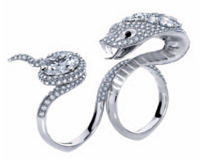 |
|
Diamonds Above
$20K
Stephen Webster won
in the Diamonds
Above $20K category
for his Temptation of
Eve ring, which
features 7.75 carats
of Forevermark
diamonds, 3.34
carats of white pave
diamonds and black
onyx set in 18-karat
white gold. |
Gold
Majoral’s 18-
karat yellow
gold necklace
won in the
Gold
category. |
x |
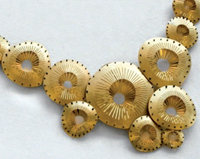 |
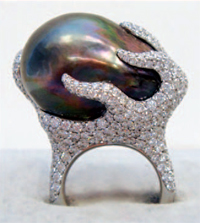 |
|
Pearls
Mikimoto’s baroque black
South Sea cultured pearl and
diamond ring, set in 18-karat
white gold, took first place in
the Pearls category. |
Coloured Gemstone Below
$20K
Rodney Rayner won in the
Coloured Gemstone Below
$20K category with his Via
Roma ring, made in 18-
karat rose gold with orange
sapphires, champagne
diamonds, white diamonds
and irregular faceted
citrine and smoky quartz
centres, with a citrine centre
stone. |
|
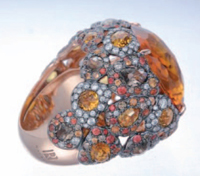 |
|
|
The Couture Design Awards recognize the best in fine jewellery design. |
| |
Graham London’s Silverstone Tourbillograph,
an automatic one-minute tourbillon chronograph
wristwatch, won in the Technical category of the
Couture Time Awards.
Bremont’s aviation-inspired ALT1-WT watch
took first place in the inaugural People’s Choice
category of the Couture Time Awards. |
| |
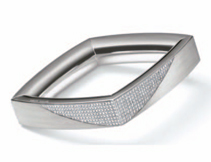 |
|
Platinum
Heinrich &
Denzel’s Arcus
bangle with 268
brilliant diamonds
set in platinum
took first place in
the Platinum
category. |
Diamonds Below
$20K
This bracelet by
Moritz Glik with
rose-cut and
brilliant-cut
diamonds
enclosed in
double white
sapphires in 18-
karat yellow gold
and blackened
silver took first
place in the
Diamonds Below
$20K category. |
|
 |
|
| From left: Jan Mohr, of Couture retailer relations; Jim DeMattei,
president of Viewpoint; David Rocha, executive director at Jewelers
for Children; and Chris Casey, publisher of National Jeweler and vice
president of Nielsen’s jewelry exposition group. |
Coloured Gemstone
Above $20K
This bangle by Lydia
Corteille is made in
18-karat gold with
brown diamonds,
tsavorites, green
turquoises and
emeralds and took first
in the Coloured
Gemstone Above $20K
category. |
|
|
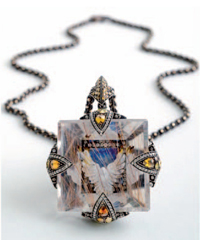 |
|
Debuting at Couture
Sevan Bicakci was
recognized with the
Debuting at Couture
Award for his Magical
Peacock pendant, made
with silver, white and
brown diamonds and a
carved rutilated quartz
centre stone set in 24-
karat gold.
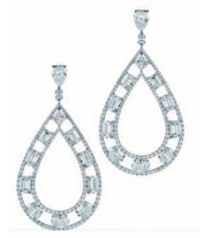 |
People’s Choice
The People’s Choice
Award was given to Kwiat
for these platinum and
diamond earrings from
the Legacy Collection. |
|
|
| |
|
|
|
|
| |
Queen Elizabeth's 10,000 diamonds on display in London |
|
| |
|
|
| |
1 & 2 The Jaipur Sword and
Scabbard, set with 719
diamonds weighing a
total of 2,000 carats,
originally presented to
King Edward VII for
his coronation in 1902.
3. The Coronation Necklace.
4. The Diamond Diadem Tiara, worn by Queen Elizabeth II on British
and Commonwealth stamps, also features on some issues of coinage
and bank notes.
5. Exhibition curator Caroline de Guitaut holds the Cullinan Brooch. |
|
| |
More than 10,000 diamonds go on show at
London’s Buckingham Palace this month to mark
Queen Elizabeth’s 60th year on the throne. The
exhibition, which runs from July 31 to October 7, was
designed to coincide with the queen’s diamond jubilee
this year, and features jewels Her Majesty wears regularly
at official functions in Britain and abroad.
The aim of the exhibition is to show how rulers
have used diamonds as visible signs of wealth and
power,” said curator Caroline de Guitaut, who described
the crowns, tiaras, rings, earrings, swords and snuff box
on display as “priceless.” De Guitaut said the 86-yearold
monarch was consulted on what would be used for
the exhibition, housed in a darkened room inside
Buckingham Palace and accessed via gilded,
colonnaded corridors lined with royal portraits going back generations.
“We have
tried to showcase
some of the very
most important
diamonds in royalpossession.” The
first item on show
in a brightly lit glass
case is Queen
Victoria’s small
diamond crown
which, despite its
size, features more than 1,100 diamonds. After her
husband Prince Albert’s death in 1861, Queen Victoria,
the only other British monarch to have marked a
diamond jubilee, wore only mourning clothes, meaning
that colourless stones such as clear diamonds were an
ideal adornment. Queen Victoria was regularly pictured
wearing it, including in her official diamond jubilee
portrait.
|
|
| |
|
|
| |
6. Queen Victoria’s Fringe Brooch. 7 & 10 Caroline de Guitaut, Curator of Royal Collections, holds the Delhi
Durbar Tiara, which was loaned to the Duchess of Cornwall in 2005.
8. A view of the Cullinan VII (Delhi Durbar Durbar Necklace and
Cullinan Pendant) 9. A diamond-set Coronation Fan, made for Queen Alexandra at the
time of the coronation in 1902.11. Exhibition curator Caroline de Guitaut poses with the Cullinan VII
necklace. |
|
| |
Perhaps the most impressive display, however, is
that containing seven of the nine major stones cut from
the Cullinan Diamond, the largest ever found. The
stone was discovered in South Africa in 1905 and was so large that a clerk working at the mine initially threw
it away, assuming it was a worthless crystal. Eventually,
though, the stone weighing 3,106 carats in its rough
state, was presented to King Edward VII who decided
to have it cut and polished. It produced 9 principal
stones and 96 small brilliant diamonds. The two main
gems, the largest colourless and flawless cut diamonds
in the world, were set in the Sovereign’s Sceptre and
Imperial State Crown.
Like many of the important diamonds in the
exhibition, Cullinan III and IV were used in a variety of
settings over time, but today form a brooch worn by
Queen Elizabeth at a service of thanksgiving at St.
Paul’s Cathedral last month. Cullinan V is in a brooch,
Cullinan VII hangs as a pendant from an emerald
necklace, Cullinan VI and VIII are also in a brooch, and
Cullinan IX, the smallest of the nine main stones at 4.4
carats, is set into a platinum ring.
Underlining how diamonds were used as gifts of
diplomacy as well as objects of desire, Queen Victoria’sfine fringe brooch
includes the stones
presented to her by
the Sultan of Turkey
as a token of thanks
for Britain’s support
in the Crimean War.
Victoria appears not
to have appreciated
the sultan’s tastes,
and had the jewels
reset.
|
|
| |
|
|
| |
12.Diamond encrusted: A table snuff box owned by Frederick the Great
of Prussia, incorporating nearly 3,000 diamonds, which was
purchased by Queen Mary in 1932.
13. A vitrine containing Queen Mary’s Girls of Great Britain and Ireland
Tiara.
14. The Queen’s Williamson Diamond Brooch.
15.The Diamond Diadem. |
|
| |
The Jaipur
Sword and Scabbard
were presented to
King Edward VII for
his coronation in
1902 by the Maharajah of Jaipur, and have been set
with 719 diamonds weighing 2,000 carats in total.
More recently, Queen Elizabeth was gifted the
Williamson Diamond in 1947 by Canadian geologist
and royalist John Thorburn Williamson, and it is
considered the finest pink diamond ever discovered. From its original uncut 54.5 carats it was cut into a 23.6-
carat round brilliant stone and now sits in the centre of
a flower-shaped brooch by Cartier. While de Guitaut
said she could not even guess the value of the diamonds
on display, a pink diamond of similar size without royal
provenance, fetched $46 million at an auction in
Switzerland in 2010.
Of all the royals represented in the exhibition,
Queen Mary’s name came up most often. Queen
Elizabeth’s grandmother clearly had a passion for
jewellery, and among her acquisitions was a snuff box
made originally for Frederick II of Prussia and his court.
The box is covered with nearly 3,000 diamonds,
including many on the bottom which would normally
be invisible, and came to England after the Russian
Revolution. There it was sold twice before being
purchased by Queen Mary in 1932. |
|
| |
|
|
| |
Recycled Diamonds Integral to supply |
|
| |
“Last year was an excellent
year for us,” said the outgoing De
Beers chairman Nicky
Oppenheimer at a party with clients. “If you didn’t make money, then
you are obviously in the wrong
business,” he semi-quipped before
a stunned audience. Looking at the
macroeconomics of the diamond
pipeline from rough production to
wholesale sales of polished, the
trading and manufacturing sectors
as a whole did not make money on
their trading activity, though they
earned on inventory appreciation.
Those who restocked rough
in the first eight months of 2011
saw DTC rough selling prices rise
by some 44 percent, just to witness
a steep fall of some 16 percent in the
last part of the year. The DTC clearly
abandoned its time-honoured policy
of only raising prices to so-called“sustainable” levels. Looking at the
composite price index, for all
qualities and sizes, we saw a
doubling of rough prices in the past
two years again outpacing the
increases in polished, only to end at
lower levels.
A Good Year?
If we take an average 15-20
percent in inventory appreciation
over the year (including polished),
the industry did make US$2-US$3
billion overall, though this would
be because of higher prices – and
through no efforts by the players
themselves. The euphoria expressed
by Nicky Oppenheimer was, in a
sense, not “out of place”; but it was
a “good year” for the wrong
reasons. Also, a large part of the
(potential) paper earnings remain
in inventory until they materialize,
thus, actually, representing “future
music.” So, last year was excellent
if you were a rough producer or a
jewellery retailer. That is where the
real profits were, and, of course,
these are the core businesses that
the Oppenheimer family has now
sold to Anglo American.
|
|
| a) Mr Claim Even-Zohar b) Mr Nicky Oppenheimer |
Looking at the Pipeline
As it takes about a year and a
half for a diamond to move through
the value chain from rough
acquisition to polished sales (at
polished wholesale prices), the price
volatility has made it far more
challenging to present an accurate
picture for the year that was. Even
producer countries vary in their
reporting methodologies of mining
output values.
Just look at the volatility in
the reported average values of world
(run of mine) output, which totalled
about US$95 per carat in 2008,
plunging to US$72 per carat in
2009, recovering to US$98 per carat
in 2010, and then climbing to
US$121 per carat in 2011. This
shows an enormous (and
unsustainable) jump. For 2012, we
expect the average world output to
decline to US$108 per carat, also
because of the expected stepped-up
production from the (cheap goods)
Argyle mine and growing Marange
output.
Last year, natural diamond
production came to some 125-130 million carats valued at US$15.2
billion. This output moved through
the pipeline resulting in US$22.6
billion worth of polished. The
overhang in the 2011 pipeline is an
estimated US$1.3 billion of rough
and polished expressed in polished
wholesale prices at year end. It is
this overhang that will also impact
the rough demand for 2012.
Worldwide diamond jewellery
retail sales came to
US$70.8 billion. The market share
of America in diamond consumption
was reduced to 38 percent. The
other major traditional market,
Japan, declined further to merely
an 8 percent share. In a neck-toneck
race to be the second-largest
diamond-consuming nation is India,
with 12 percent market share,
followed by China (the mainland)
with 11 percent. Hong Kong is
accounting for 2 percent. |
|
| c) Argyle mine d) A model displays diamonds at a De Beers Show. Recycled diamonds, experts say, could be devaluing the minerals used in engagement rings and necklaces. |
The Recycling Factor
The value of the diamond
content in retail sales in 2011 came
to US$23.6 billion. The vast majority
of this amount (US$22.6 billion)
comes, of course, from either
recently mined rough or inventories.
The new reality is, however, that
some of the polished comes from
recycled diamonds — diamonds that
consumers have held for many years
or even for generations but now felt
the need to sell in order to pay
mortgages, medical care, children’s
education or even to supplement
pensions or to pay debts.
We want to be very careful
here — this is definitely not a new
phenomenon. Anyone who has
followed the trade of pawn shops or
is familiar with high-street family owned
jewellery businesses knows
that there has always been an
element of selling off “old” estate
jewellery. Many New York diamond
manufacturers have built quite a
reputation for their “re-cutting
skills,” turning old shapes into more
fashionable goods. However, since
the advent of the last economic
crisis, the volumes of diamonds held
by consumers coming back into the
pipeline have skyrocketed. Literally
hundreds of diamond businesses
have developed special niche
expertise in this area. Those recycled
diamonds are mostly sent to India
or other cutting centres for recutting.
A large part of the diamondrecycling
supply side takes place in
invisible parallel markets, defying
effective monitoring. It’s easier to
measure gold recycling, as there,
the jewellery needs to be refined
through a limited number of known
refineries. When, in early 2009,
jewellery scrap fabrication
exceeded new mining supplies, one
got a further indication of the
intensity of this movement of goods
back into the pipeline.
We have estimated that
recycled diamonds sold again to
the jewellery sector came to about
US$1 billion in 2011, which
represents 4.4 percent of all polished
diamonds sold at polished wholesale
prices. This is quite significant, and
it has definitely become a supply
factor that requires serious thought
by pipeline participants, especially
producers, when estimating supplyand-
demand trends. They do tend
to soften polished retail prices, as
retailers’ huge profits on recycled
goods allow them more breathing space in selling polished. |
|
| e) The 2011 diamond pipeline
‘Global Household Mine’
Just as one is very conscious
about the depleting diamond
reserves of existing mines, it is
worthwhile to take a look at what
the so-called “Global Household
Mine” has in stock. What are its
potential reserves? Unfortunately,
diamonds last forever… they don’t
just disappear, nor are they being
thrown away together with old
furniture, books or other junk piling
up in people’s attics. The supply of
recycled diamonds is driven by
various functions — not only by
economic necessities but also by
the high prices.
One tends to assume, or one
likes to believe, that diamond
possession is solely a very
emotional phenomenon, but this is
not universally true. In India, for
example, diamonds and gold in the
hands of consumers are often viewed
as assets. In parts of the Arab world,
this holds true as well. So what are the Global Household Mine
reserves?
Since ancient days, diamond
mines have produced some 5.2
billion carats, which at 2011 rough
production values (US$121 per
carat), would amount to some
US$625 billion worth of rough. The
historically adjusted gem-quality
polished output would be between
1.3-1.6 billion carats. (Traditionally,
no more than 15-20 percent of
output was considered cuttable; that
changed in the 1960s with the
emergence of the near-gems.) The
worldwide average polished sale
price (at polished wholesale prices)
is US$625 per carat. Therefore, the
Global Household Mine probably
holds US$0.7-US$1 trillion worth
of polished diamonds at current
prices. About 40-50 percent of these
diamonds would be held in America.
This is a staggering amount.
In 2011, about a minimum of
US$1 billion of recycled polished
came back into the market — which,
by value, represents 4.4 percent of
polished retail demand. (It could be
more but it won’t be less.) The
really amazing, if not frightening,
figure is the “stock withdrawal” of
the Global Household Mine: the
US$1 billion figure represents
merely 0.1 percent of stocks by
value. Indeed, theoretically, the
Global Household Mine could meet
the consumers’ requirements, at
current levels, for about 35-45
years! As most women will not likely
depart from their diamonds that
easily, it is certainly not an
immediate concern. But it must be
part of a proper pipeline analysis.
There is an additional “recycling”
market in the making: investment
diamonds. So far, a dozen or so new
companies or structures purchase
polished for investment purposes.
These diamonds will come back in
at some point, but now there are
mostly buyers and not sellers.
|
 |
Retail Environment
Everything is relative. Though
mining costs in absolute terms may not have increased so much since
2008, the higher price levels of the
output have dramatically doubled,
and in some instances, even tripled
mining profits. This is quite evident
in the evolution of profit sharing in
the value chain.
There are other pipeline
parameters that have gradually
changed over time, making them
less valid for comparison. The total
retail value of diamond jewellery
pieces is one of these. An analysis
of the diamond content in the final
jewellery product shows that the
ratio between diamond and other
used materials/costs has changed.
A decade or so ago, diamond
content (at wholesale polished
prices) would represent about 20
percent of the jewellery piece’s total
retail price. In some countries, like
England for example, it was even
less, more like 18 percent.
On the other extreme, there
were markets (such as Indonesia)
where diamond content might have
been at an average 60 percent of the
total diamond jewellery piece. This
has to do with overheads, retail
structure, taxes, etc. So, worldwide,
diamond content might have been
at averages of some 21 to 22 percent.
This has gradually changed.
Our research indicates that,
worldwide, the share of diamond
content in jewellery pieces has
increased to some 32 percent. There
are many reasons for this. One factor
is the shift of markets from the
United States (the so-called “junk
market”) to the far more valueconscious Far Eastern market. The
higher gold price has also
contributed to containing more
diamonds and less gold in an
industry that is at pains to meet
certain price points. Also less
expensive materials are increasingly
being used in the final product.
So, our global diamond retail
sales figure of US$70.8 billion
actually holds more diamonds (by
value) than this figure would have
contained a decade ago. (Or, to say
it differently, taking the US$23.6
billion of diamond content sold in
2011 (which we consider a hard
figure), and if one would
hypothetically assume only 22
percent wholesale diamond content
in the final retail piece, worldwide
diamond retail consumption would
have been calculated at US$100
billion.) |
|
But this clearly isn’t the case;
it is merely pointed out, as some
analysts may also arrive at higher
diamond jewellery retail values for
a variety of reasons. This often has
more to do with methodology and
data collection than with anything
else. Tacy Ltd. has done its pipeline
for 23 consecutive years, and we
believe our figures closely represent
the reality. We recognize, however,
that some researchers base figures
on telephone surveys of consumers,
on feedback from jewellers, on
financial reports from large retailers,
or statistics, etc. For the diamond
industry, there is only one figure
that really counts: how many
diamonds were sold in 2011. That
figure is US$23.6 billion at polished
wholesale prices.
2011 in Perspective
In the pipeline, each and every
diamond is only counted once, and every stone is basically cut and
polished only in one principal
location. Looking by value, we see
now that close to 70 percent of all
diamonds by value are
manufactured in China and India,
with some 13 percent in the southern
African and Russian beneficiation
countries. The role of Belgium,
Israel and the United States as
traditional cutting centres has
gradually been diminished to close
to insignificant figures. In terms of
manpower, these latter countries’
cutting labour force can be
measured in the hundreds rather
than in the thousands. In terms of
“number of stones,” we certainly
can say that 14 out of 15 diamonds
are cut and polished in India and
China.
It is important to neutralize
“double accounting,” which is
difficult as every stone may move
many times through multiple
jurisdictions. If one looks at
Belgium, for example, its 2011
polished exports are close to US$15
billion, well over 30 percent higher
than the previous year. But in terms
of added value produced through
manufacturing, there wasn’t more
than US$200 million, and only
US$1.1 billion (7.5 percent of total
polished export value) can be
attributed to domestic
manufacturing. Like the Israelis and
Americans, Belgians do most of
their manufacturing in China,
southern Africa, Asia and elsewhere.
The 2011 pipeline likes to capture
the added value generated between
the various phases of activity.
The traditional conventional
wisdom that trading centres also
require domestic manufacturing has
valid marketing purposes as it adds
to the illusion that one can find
“freshly cut and polished diamonds”
in that market. That “wisdom”
definitely belongs in the past.
|
|
| |
|
After the Crisis
In terms of numbers, global
retail demand in 2011 increased by
10.3 percent compared to the
previous year. However, it is still
slightly below the 2007 pre-crisis
level. In 2012, our models,
developed jointly with my
colleague Pranay Narvekar of
Mumbai-based Pharos Beam
Consulting, show that global retail
demand is set to increase by 8.3
percent. This definitely takes us well
above the pre-crisis levels. The total
polished wholesale demand in 2011
of US$23.6 billion is about 19.4
percent above the previous year.
That sounds like a lot, but given the
price movements it doesn’t point to
an increase in volume terms. One of
the reasons for the year to have
been challenging is that in 2010,
polished demand from the cutting
centres was 38 percent above the
previous year. So, the growth
sentiment in 2011 was only half of
that experienced in 2010. This is not the time to discuss the ripple
effect, which clearly validates those
figures.
On the rough demand side,
2011 saw a 35.2 percent increase
over the previous year. This trend
will not continue, and our models
suggest that rough demand will
actually decline slightly in 2012.
The same counts for the cutting
centres. Though in 2011 we saw a
growth of polished demand of 19.4
percent, this will slow down to 6.2
percent in 2012. So, while 2011
was quite a trying year for the
downstream industry in which
profits mostly came from higher
diamond values, 2012, if anything,
will be more difficult.
There is also concern about
the producers’ pricing of rough.
There is strengthened fixation on
their bottom lines, which triggers
considerable rough price volatility.
As mentioned earlier, the historical
commitment to sustainable rough
prices is something of the past. BHP
Billiton pioneered the linkage of its
long-term contract prices to the
behaviour of spot-market auctions.
It seems that De Beers is following
in their footsteps and that the prices
secured by the Diamdel auctions
may well guide the pricing of DTC
sight boxes under the new threeyear
contract. Expect in 2012
continued volatility of 5-10 percent
in both directions — with the overall
price levels going sideways.
The cutting and trading centres
may be in for quite a squeeze in
2012. Earnings need to come from
activity rather than from stock value
appreciation. Actually, such a
squeeze shouldn’t bother the
downstream players too much —
they have grown used to it.
— Courtesy of Diamond Intelligence Briefs
|
|
|
| |
|
|
|